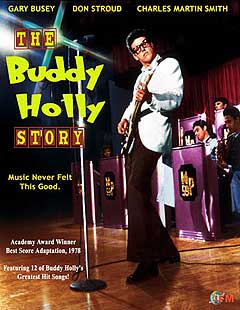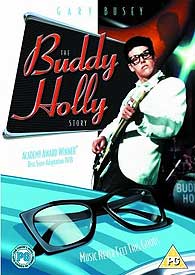 The singing in The Buddy Holly Story (1978) is pretty darned good. The music of Buddy & the Crickets would've been grand enough to carry this film even if it had been dramatically weak. But dramatically it's also pretty darned good.
The singing in The Buddy Holly Story (1978) is pretty darned good. The music of Buddy & the Crickets would've been grand enough to carry this film even if it had been dramatically weak. But dramatically it's also pretty darned good.
It is not often biographically true to the facts. How the band came to be called the Crickets for instance is amusing, but as shown, not factual. Still, it all makes a good tale, & is true to the spirit of Buddy's short productive life.
He's shown in the early 1950s in Lubbock Texas where he's all but persecuted, & certainly discouraged, from playing "bop" music. His parents' disapprove; his creepy girlfriend disapproves of his thinking of music as anything more than a "hobby."
Even the local radio station's owner-manger who delights in Buddy's music risks losing advertisers if he airs any more live concerts in which Buddy's band refuses to stick to western tunes. All this is in extreme contrast, the young & the powerless adore Buddy's band.
When they set out for Nashville, the first recording session is with a loony producer trying to turn "That'll Be the Day" into a hillbilly tune. This is a truly tragically miserable experience, & played pretty close to the history of Buddy's first misstep toward success.
Life & love & a music career are so ultra crappy, you just can't wait for the poor bastard to get the hell out of Lubbock & never go back.
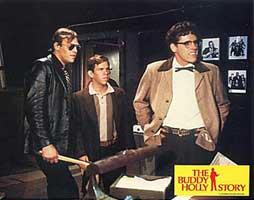 Buddy gets a long distance phone call from radio personality "Madman Mancuso" (Fred Travalena) who wants to talk on the air about Buddy's first hit tune. Here's where things really start to turn around, because Buddy wasn't even aware that his submitted demo had been pressed. Mancuso plays Buddy's fine garage mix of "That'll Be the Day" twenty-four hours non-stop, a mythic moment joyful to see. Buddy gets a long distance phone call from radio personality "Madman Mancuso" (Fred Travalena) who wants to talk on the air about Buddy's first hit tune. Here's where things really start to turn around, because Buddy wasn't even aware that his submitted demo had been pressed. Mancuso plays Buddy's fine garage mix of "That'll Be the Day" twenty-four hours non-stop, a mythic moment joyful to see.
The way Buddy is portrayed pursuing his sound like an artist who does have some business sense is great. How the Crickets as a white group get to the Apollo Theater to perform on the same bill with Sam Cook is a super story in itself, performing "Oh Boy" & "It's So Easy" to a thrilled audience who it was predicted would boo those Texans off the stage.
The romance between Buddy & wife to be Maria Elena Santiago (Maria Richwine) is developed just right, not sappy, not trivial, with Buddy's gentlemanliness toward Maria's guardian Puerto Rican aunty (Neva Patterson) is as endearing as the love story itself.
The Buddy created on the screen is a likeable, decent, but by no means fluffy guy. He's a great cinematic character & it's lovely to think he may have been a lot like this for real. He's also sexy as portrayed by Gary Busey.
Given Busey's later image as a dangerous & out of control self-destructive actor cum religious wackjob after nearly doing himself in, it may seem odd that as a younger actor he could play this kind of intelligent innocence so perfectly. He wasn't all that young really; he was a good decade older than Buddy lived to be. But he lost something like 40 pounds in order to fit the role physically, to which we may add that he was & remains a damned good actor.
And this is certainly among his finest roles, if not the finest. A certain lack of flamboyance in the production strengthens it as a story of character, & Gary was just the actor to make it pay off.
He also sang the role himself which gave the performances the purest verisimilitude. Sure, if you play Buddy along with him, he ain't Buddy, but he does the material justice, & he makes these performances, so central to the success of the film, credible & planely exciting.
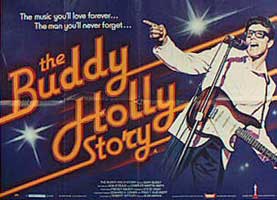 Of course, everyone knows how Buddy died along with the Big Bopper & Ritchie Valens on 2 February 1959, so even the film's most upbeat moments have this underlying sense of tragedy.
Of course, everyone knows how Buddy died along with the Big Bopper & Ritchie Valens on 2 February 1959, so even the film's most upbeat moments have this underlying sense of tragedy.
The Buddy Holly Story was a story truly worth telling, & between the right director & the right actor, it was done justice. That the last song for his last performance would be "Not Fade Away" remains eternally heartbreaking.
The greater bulk of the film is played in an upbeat manner, like the tunes themselves. It's not all fun & games, though. Before the "Maybe Baby" nmight on the Ed Sullivan Show, there was in-fighting of the worst sort between the Crickets, jealosy, drunkenness, & Buddy getting a tooth knocked out just before going on the air for a comparatively lackluster show.
Don Stroud as drummer Jesse Charles & Charles Martin Smith as bassist Ray Bob Simmons are also good, but really this is a one-man show, & when Jesse & Charles fink out with crushed egos over Buddy's front man status, & with hick mentality are convinced Lubbock is the only place they can be, it comes off as a sad combination of their betrayal even of themselves, against Buddy's unyielding pride.
Crickets fans will note right away that these aren't the real names of the Crickets bandmates, which numbered three not two. For some this alteration of reality was the equivalent of making a biopic about the Beatles as a three-lad band.
And it is with these side-portraits that the film nearly derails itself with unpleasant inventions that were a great injustice to the actual bandmate,s who weren't the relentless retards the film has them being, but legitimately contributed to the Crickets' sound.
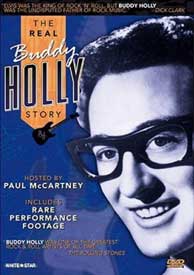 That the actual Crickets sans Buddy were pained by this film is really too bad, as it wasn't necessary even for dramatic effect to make them that much inferior to Buddy as human beings.
That the actual Crickets sans Buddy were pained by this film is really too bad, as it wasn't necessary even for dramatic effect to make them that much inferior to Buddy as human beings.
But from a viewer's point of view this injustice easily goes unnoticed since it's true in this film even if not to history. Buddy has & merits our fullest attention. It bares a reminder, though, that this is Buddy's life as impressionist drama, & the portraits of people around him shouldn't be taken as more than fiction.
Recommendable documentaries closer to the facts of it all would be The Real Buddy Holly Story; aka, Buddy Holly (1985), & The Music of Buddy Holly & the Crickets: The Definitive Story (2005).
Paul McCartney funded & introduced The Real Buddy Holly Story in which we get a beautiful sense of the lingering sadness & essential loving goodness of the Crickets bandmates, friends, & family members, interviewed about their memories of Buddy.
Bob Montgomery, J. I. Allison & Joe B. Maulden certainly aren't the racist bumpkins the fictional film redacted them to. The truth is they felt lucky & honored to be embraced & invited across race barriers to play in black theaters & alongside such giants of the era as Chuck Berry & Little Richard, & they were in awe of these influences on their own music.
They may be "country" & they weren't geniuses like Buddy, but they were & are good eggs who from earliest youth listened to "race music" & loved it & sang their hearts out as if race didn't matter. And Buddy's mates contributed mightily, in all humbleness, to Buddy's achievement.
The documentary is spiced with recordings & film footage of performances from the pre-Crickets days around Lubbuck, & with early television performances in which we can see all four Crickets lively & exciting. Through Paul McCartney's valentine to Buddy Holly & friends, we may all understand the magic & glory that rose like a flame, before the music died.
copyright © by Paghat the Ratgirl
|
